Abstract
There is no consensus opinion on whether or not cognitive impairments are found in the Silver-Russell syndrome. An investigation of a substantial sample was undertaken, using standardised assessments, in 20 boys and five girls aged 6.0 years to 11.8 years. Mean (SD) birth weights were -2.65 (0.95) SD scores, corrected for gestation. At evaluation the children had a mean (SD) age of 8.8 (1.8) years and a mean height of -2.26 (1.5) SD scores. Tests of cognitive abilities included assessments of general intelligence, reading and arithmetic attainments, and a cognitive processing task. Most had some degree of developmental delay: mean (SD) full scale IQ was 86 (24); 32% scored within the learning disability range (that is, IQ < 70); 40% were reading at least 24 months below their chronological age. Current head circumference correlated highly with full scale IQ. Assessments of special educational needs had been completed on 36%; 48% were receiving speech therapy. Approximately half of children with the Silver-Russell syndrome have significant impairment of their cognitive abilities.
Full text
PDF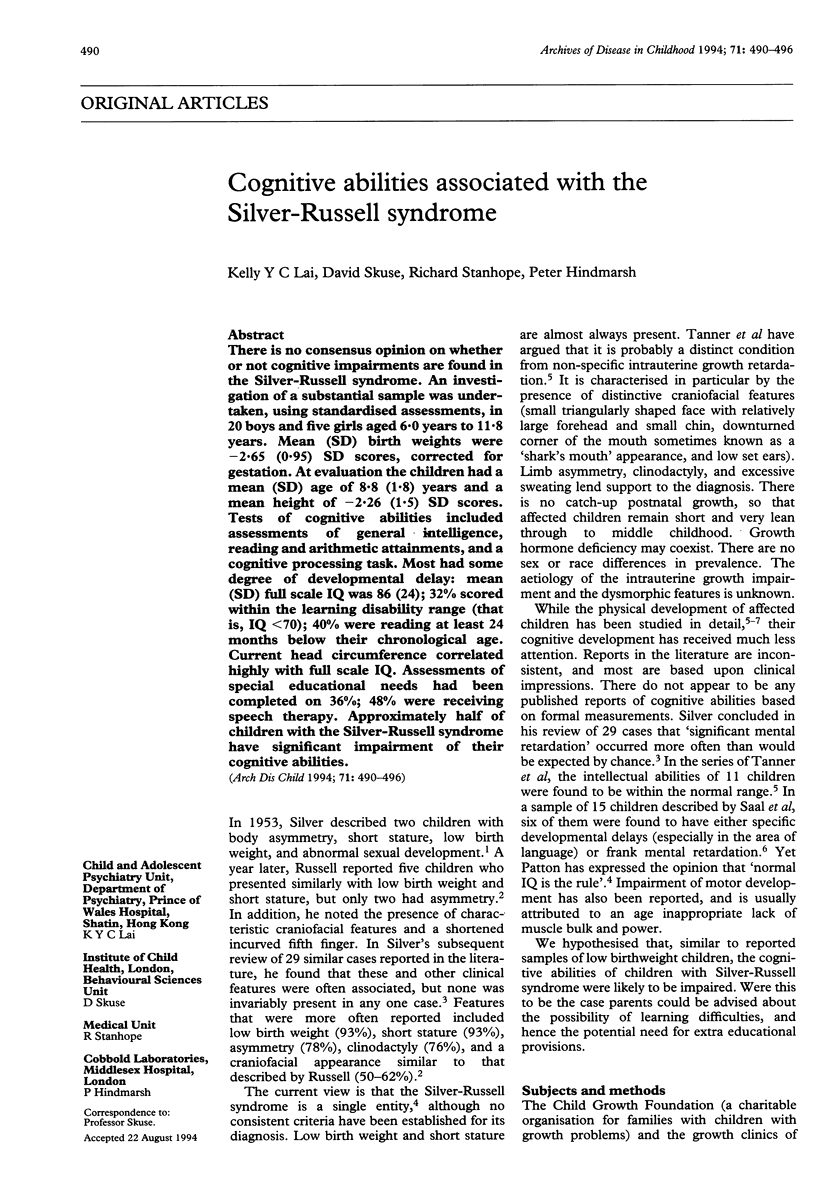
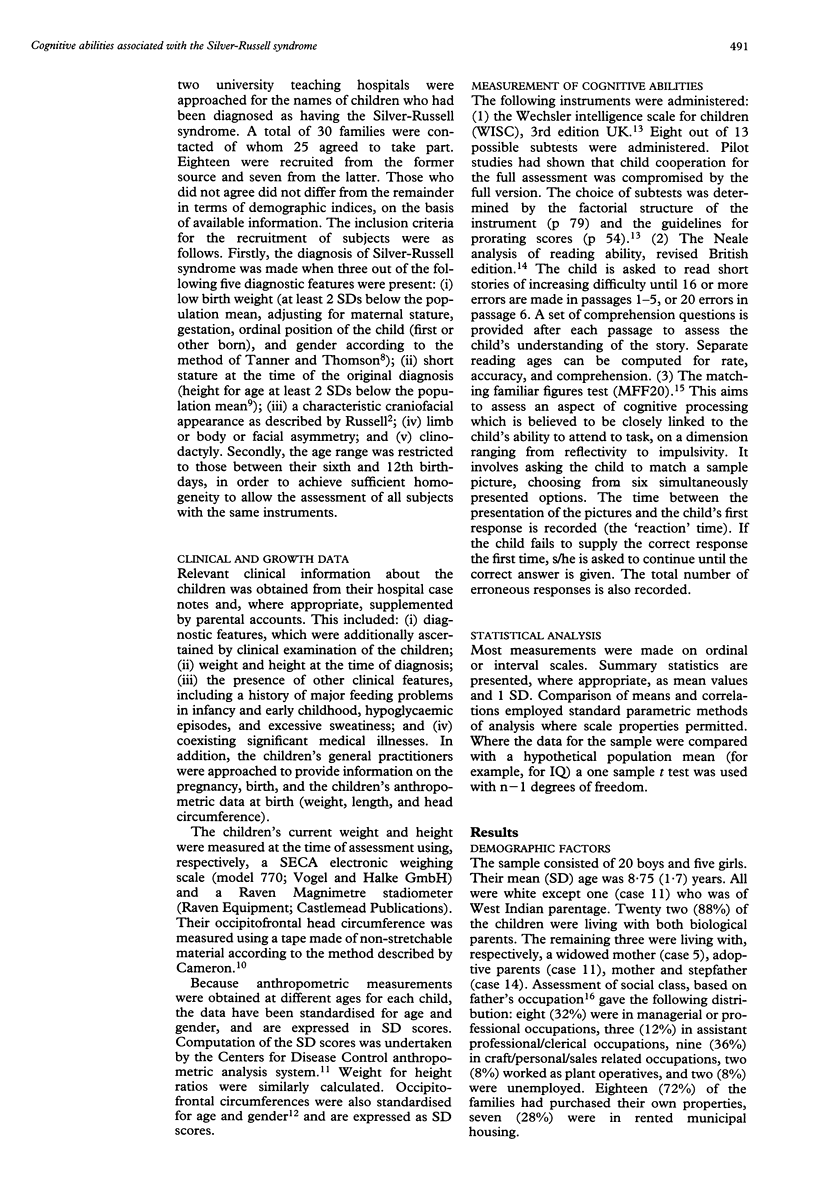
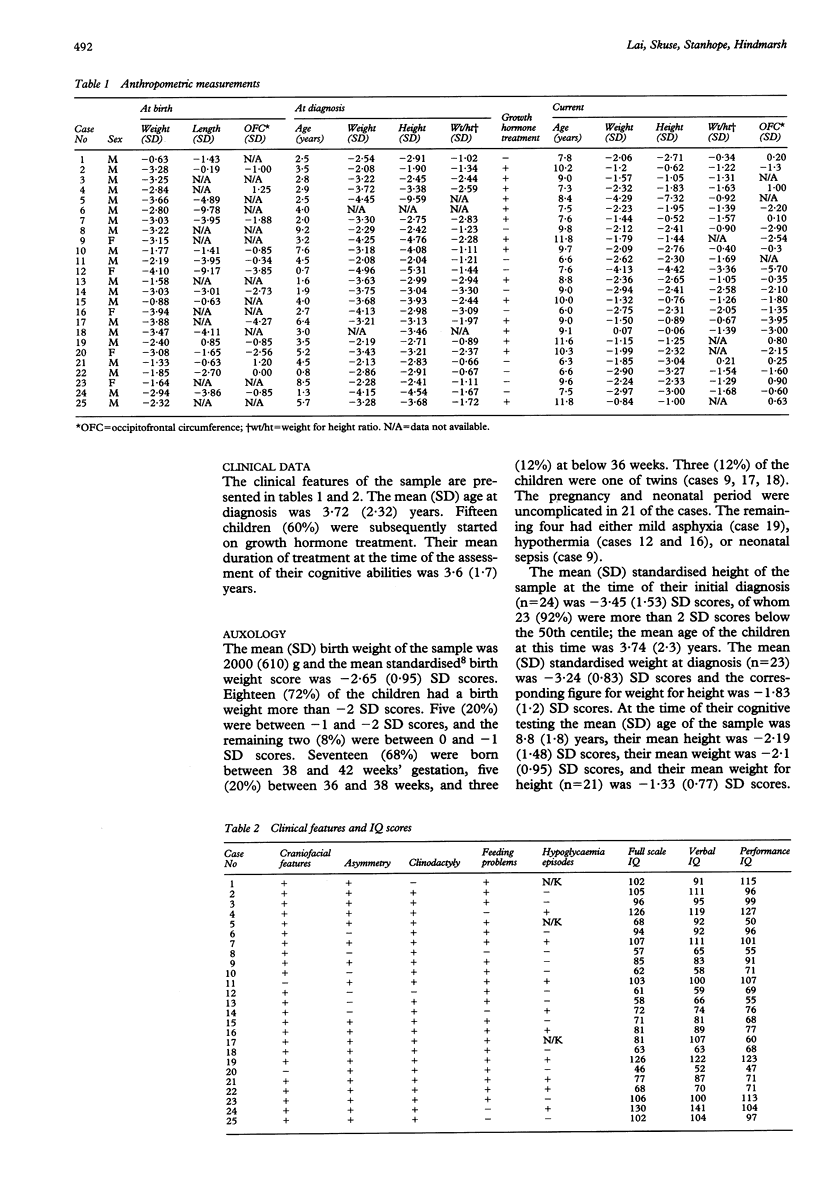
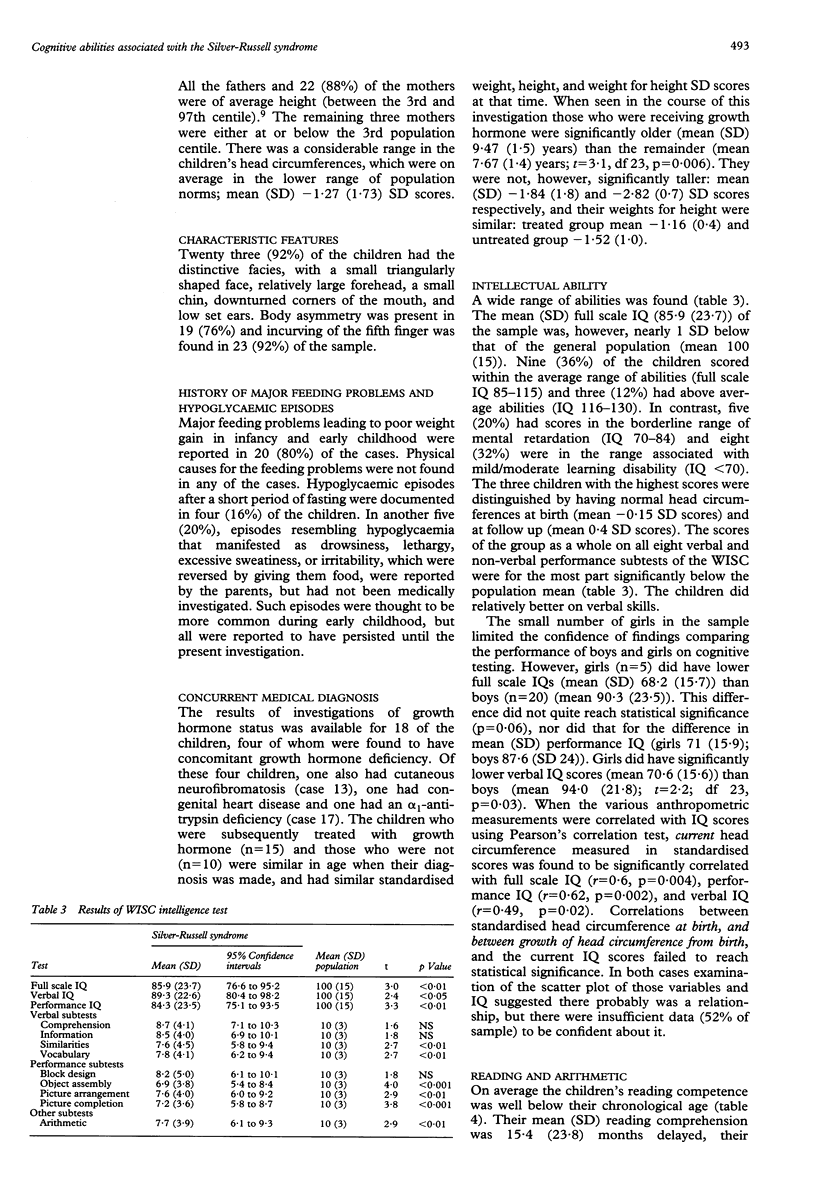
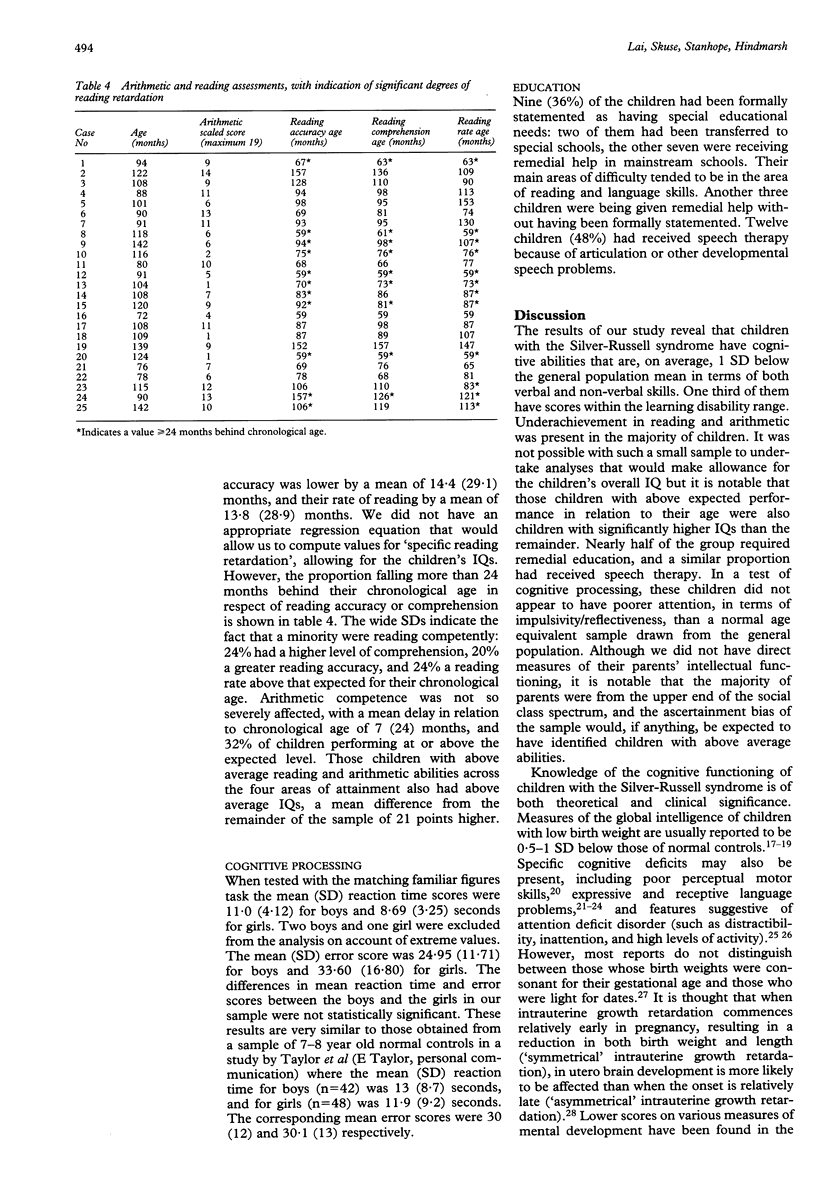
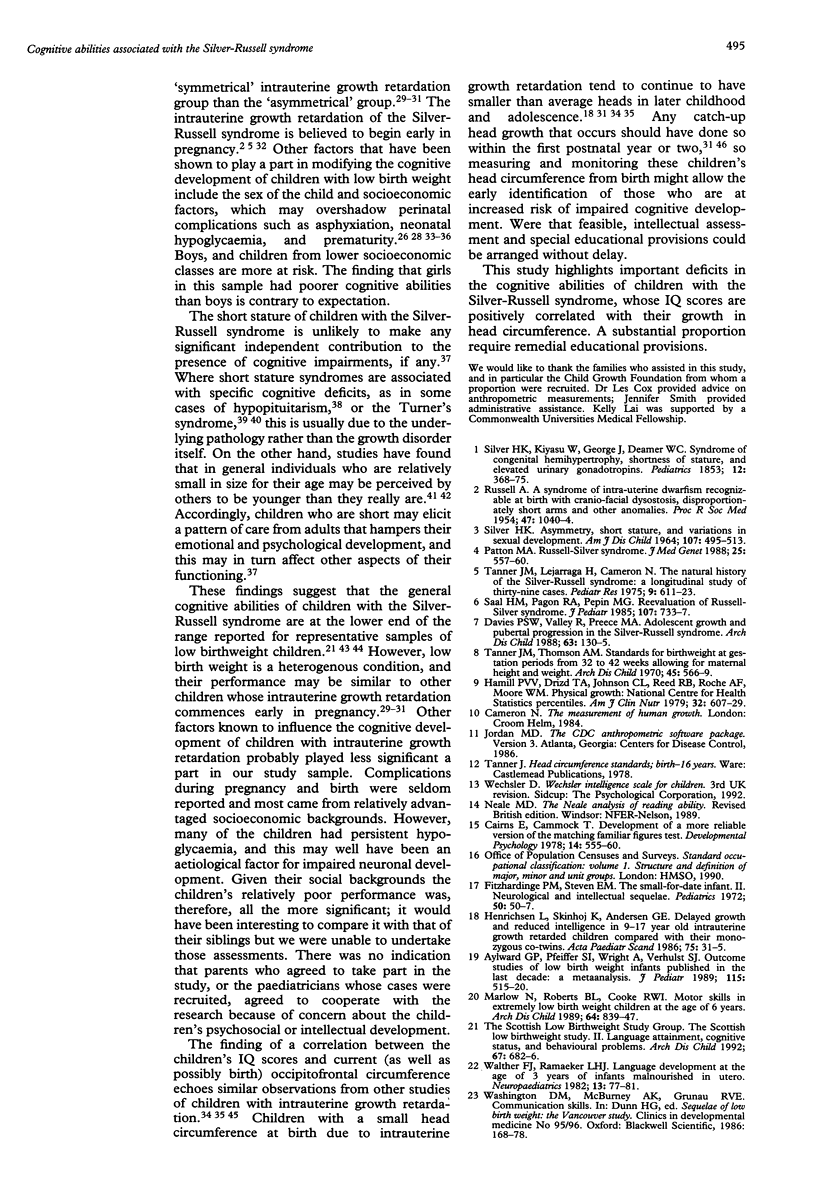
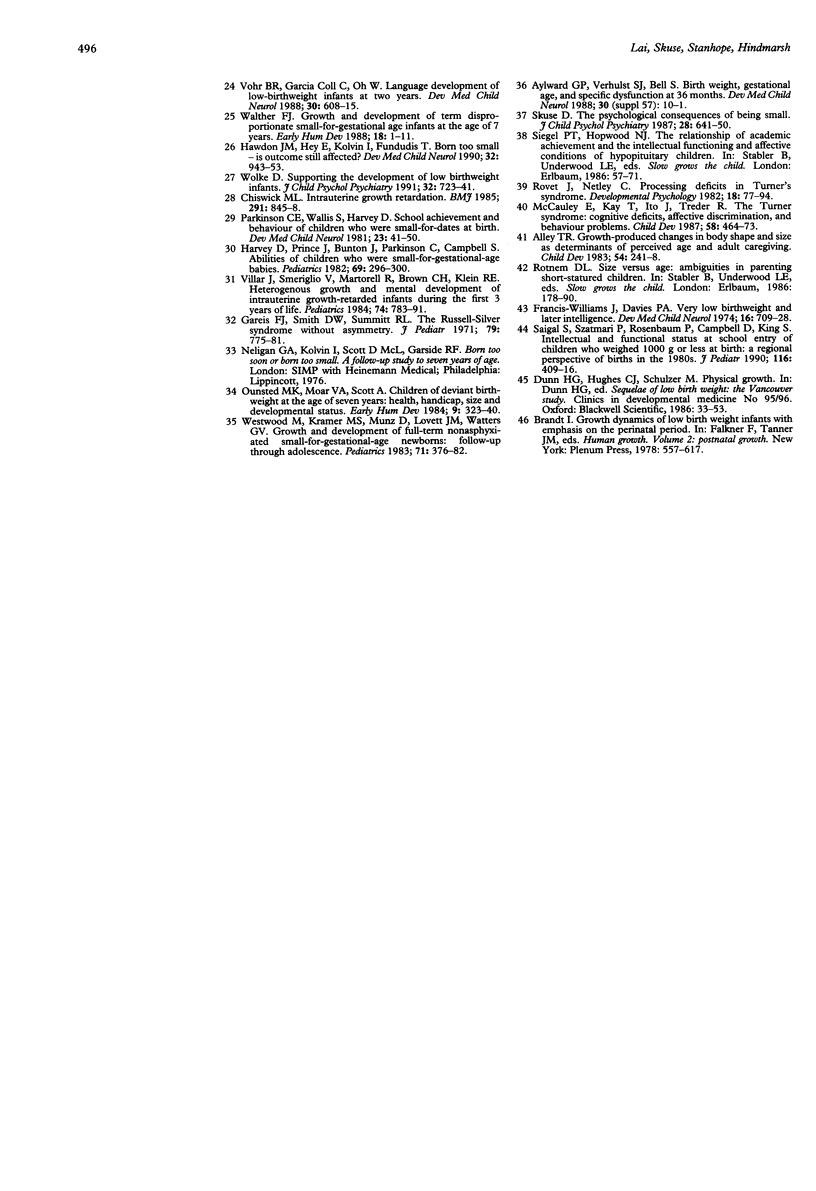
Selected References
These references are in PubMed. This may not be the complete list of references from this article.
- Aylward G. P., Pfeiffer S. I., Wright A., Verhulst S. J. Outcome studies of low birth weight infants published in the last decade: a metaanalysis. J Pediatr. 1989 Oct;115(4):515–520. doi: 10.1016/s0022-3476(89)80273-2. [DOI] [PubMed] [Google Scholar]
- Chiswick M. L. Intrauterine growth retardation. Br Med J (Clin Res Ed) 1985 Sep 28;291(6499):845–848. doi: 10.1136/bmj.291.6499.845. [DOI] [PMC free article] [PubMed] [Google Scholar]
- Davies P. S., Valley R., Preece M. A. Adolescent growth and pubertal progression in the Silver-Russell syndrome. Arch Dis Child. 1988 Feb;63(2):130–135. doi: 10.1136/adc.63.2.130. [DOI] [PMC free article] [PubMed] [Google Scholar]
- Fitzhardinge P. M., Steven E. M. The small-for-date infant. II. Neurological and intellectual sequelae. Pediatrics. 1972 Jul;50(1):50–57. [PubMed] [Google Scholar]
- Francis-Williams J., Davies P. A. Very low birthweight and later intelligence. Dev Med Child Neurol. 1974 Dec;16(6):709–728. doi: 10.1111/j.1469-8749.1974.tb03392.x. [DOI] [PubMed] [Google Scholar]
- Gareis F. J., Smith D. W., Summitt R. L. The Russell-Silver syndrome without asymmetry. J Pediatr. 1971 Nov;79(5):775–781. doi: 10.1016/s0022-3476(71)80390-6. [DOI] [PubMed] [Google Scholar]
- Hamill P. V., Drizd T. A., Johnson C. L., Reed R. B., Roche A. F., Moore W. M. Physical growth: National Center for Health Statistics percentiles. Am J Clin Nutr. 1979 Mar;32(3):607–629. doi: 10.1093/ajcn/32.3.607. [DOI] [PubMed] [Google Scholar]
- Harvey D., Prince J., Bunton J., Parkinson C., Campbell S. Abilities of children who were small-for-gestational-age babies. Pediatrics. 1982 Mar;69(3):296–300. [PubMed] [Google Scholar]
- Hawdon J. M., Hey E., Kolvin I., Fundudis T. Born too small--is outcome still affected? Dev Med Child Neurol. 1990 Nov;32(11):943–953. doi: 10.1111/j.1469-8749.1990.tb08116.x. [DOI] [PubMed] [Google Scholar]
- Henrichsen L., Skinhøj K., Andersen G. E. Delayed growth and reduced intelligence in 9-17 year old intrauterine growth retarded children compared with their monozygous co-twins. Acta Paediatr Scand. 1986 Jan;75(1):31–35. doi: 10.1111/j.1651-2227.1986.tb10153.x. [DOI] [PubMed] [Google Scholar]
- Marlow N., Roberts B. L., Cooke R. W. Motor skills in extremely low birthweight children at the age of 6 years. Arch Dis Child. 1989 Jun;64(6):839–847. doi: 10.1136/adc.64.6.839. [DOI] [PMC free article] [PubMed] [Google Scholar]
- McCauley E., Kay T., Ito J., Treder R. The Turner syndrome: cognitive deficits, affective discrimination, and behavior problems. Child Dev. 1987 Apr;58(2):464–473. [PubMed] [Google Scholar]
- Ounsted M. K., Moar V. A., Scott A. Children of deviant birthweight at the age of seven years: health, handicap, size and developmental status. Early Hum Dev. 1984 Jun;9(4):323–340. doi: 10.1016/0378-3782(84)90077-x. [DOI] [PubMed] [Google Scholar]
- Parkinson C. E., Wallis S., Harvey D. School achievement and behaviour of children who were small-for-dates at birth. Dev Med Child Neurol. 1981 Feb;23(1):41–50. doi: 10.1111/j.1469-8749.1981.tb08445.x. [DOI] [PubMed] [Google Scholar]
- Patton M. A. Russell-Silver syndrome. J Med Genet. 1988 Aug;25(8):557–560. doi: 10.1136/jmg.25.8.557. [DOI] [PMC free article] [PubMed] [Google Scholar]
- RUSSELL A. A syndrome of intra-uterine dwarfism recognizable at birth with cranio-facial dysostosis, disproportionately short arms, and other anomalies (5 examples). Proc R Soc Med. 1954 Dec;47(12):1040–1044. [PubMed] [Google Scholar]
- SILVER H. K. ASYMMETRY, SHORT STATURE, AND VARIATIONS IN SEXUAL DEVELOPMENT. A SYNDROME OF CONGENITAL MALFORMATIONS. Am J Dis Child. 1964 May;107:495–515. doi: 10.1001/archpedi.1964.02080060497011. [DOI] [PubMed] [Google Scholar]
- SILVER H. K., KIYASU W., GEORGE J., DEAMER W. C. Syndrome of congenital hemihypertrophy, shortness of stature, and elevated urinary gonadotropins. Pediatrics. 1953 Oct;12(4):368–376. [PubMed] [Google Scholar]
- Saal H. M., Pagon R. A., Pepin M. G. Reevaluation of Russell-Silver syndrome. J Pediatr. 1985 Nov;107(5):733–737. doi: 10.1016/s0022-3476(85)80402-9. [DOI] [PubMed] [Google Scholar]
- Saigal S., Szatmari P., Rosenbaum P., Campbell D., King S. Intellectual and functional status at school entry of children who weighed 1000 grams or less at birth: a regional perspective of births in the 1980s. J Pediatr. 1990 Mar;116(3):409–416. doi: 10.1016/s0022-3476(05)82835-5. [DOI] [PubMed] [Google Scholar]
- Skuse D. The psychological consequences of being small. J Child Psychol Psychiatry. 1987 Sep;28(5):641–650. doi: 10.1111/j.1469-7610.1987.tb01549.x. [DOI] [PubMed] [Google Scholar]
- Tanner J. M., Lejarraga H., Cameron N. The natural history of the Silver-Russell syndrome: a longitudinal study of thirty-nine cases. Pediatr Res. 1975 Aug;9(8):611–623. doi: 10.1203/00006450-197508000-00001. [DOI] [PubMed] [Google Scholar]
- Tanner J. M., Thomson A. M. Standards for birthweight as gestation periods from 32 to 42 weeks, allowing for maternal height and weight. Arch Dis Child. 1970 Aug;45(242):566–569. doi: 10.1136/adc.45.242.566. [DOI] [PMC free article] [PubMed] [Google Scholar]
- Villar J., Smeriglio V., Martorell R., Brown C. H., Klein R. E. Heterogeneous growth and mental development of intrauterine growth-retarded infants during the first 3 years of life. Pediatrics. 1984 Nov;74(5):783–791. [PubMed] [Google Scholar]
- Vohr B. R., Garcia Coll C., Oh W. Language development of low-birthweight infants at two years. Dev Med Child Neurol. 1988 Oct;30(5):608–615. doi: 10.1111/j.1469-8749.1988.tb04798.x. [DOI] [PubMed] [Google Scholar]
- Walther F. J. Growth and development of term disproportionate small-for-gestational age infants at the age of 7 years. Early Hum Dev. 1988 Nov;18(1):1–11. doi: 10.1016/0378-3782(88)90038-2. [DOI] [PubMed] [Google Scholar]
- Walther F. J., Ramaekers L. H. Language development at the age of 3 years of infants malnourished in utero. Neuropediatrics. 1982 May;13(2):77–81. doi: 10.1055/s-2008-1059601. [DOI] [PubMed] [Google Scholar]
- Westwood M., Kramer M. S., Munz D., Lovett J. M., Watters G. V. Growth and development of full-term nonasphyxiated small-for-gestational-age newborns: follow-up through adolescence. Pediatrics. 1983 Mar;71(3):376–382. [PubMed] [Google Scholar]


